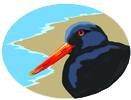In some Native American cultures, the hummingbird represents joy. On cold winter mornings, hearing this 4.5 inch bird that weighs less than 4.5 grams, singing its heart out in iridescent pink, definitely brings me joy. If you see a hummingbird in December and January, it is very likely an Anna's Hummingbird, since they are the only ones who hang out here all year.
Anna's are identified by their all-green back and gray flanks. The dark head and throat of the males, when reflected in sunlight, becomes brilliant rose red. Females also have a green back and gray flanks, and a patch of streaked red on their throat. Males aggressively defend territories of flowers. They will chase everyone including other hummers, other birds, moths and bees.
While feeding, they have an amazing ability to hover in one place by moving their wings in a figure eight. Anna's have spectacular territorial and courtship displays. The male zooms straight up, almost out of sight then speeds down towards the female. At the last moment, he spreads his wings and tail to make an explosive pop and buzzing sound. The pair will sometimes mate while in the air. Then the rest is up to the female, who builds the tiny nest by weaving and securing it with saliva and spider web. She lays two tiny, white eggs, incubates them and rears the young. Nesting can start as early as December but generally runs from February to mid-March.
Anna's Hummingbird Photo Ron LeValley www.levalleyphoto.com


